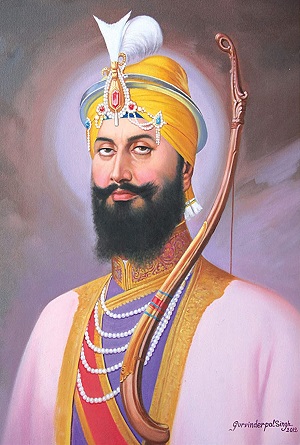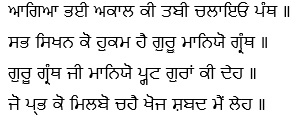Dec 28, 2025
Dec 28, 2025
Continued from Previous Page
 Guru Ji moved to Talwandi Sabo from there he sent his epistle letter titled Zafarnama to Emperor Aurangzeb. The name given to the letter by Guru Ji has moral significance of bold defiance, despite him and his family being subjected to unjust persecution for an extended period. A new recension of the Adi Granth was prepared by Guru Ji here, while Bhai Mani Singh acted as the scribe, wherein he included writings of Guru Tegh Bahadur. This place came to be known as academic center par excellence in Sikh lore. Guru Ji spent less than a year here, renaming it as Damdama Sahib. The emperor’s response to Guru Ji’s Zafarnama was received here from the south, expressing a desire to have in person meeting with Guru Ji. Accepting the invitation Guru Ji embarked on the journey towards south.
Guru Ji moved to Talwandi Sabo from there he sent his epistle letter titled Zafarnama to Emperor Aurangzeb. The name given to the letter by Guru Ji has moral significance of bold defiance, despite him and his family being subjected to unjust persecution for an extended period. A new recension of the Adi Granth was prepared by Guru Ji here, while Bhai Mani Singh acted as the scribe, wherein he included writings of Guru Tegh Bahadur. This place came to be known as academic center par excellence in Sikh lore. Guru Ji spent less than a year here, renaming it as Damdama Sahib. The emperor’s response to Guru Ji’s Zafarnama was received here from the south, expressing a desire to have in person meeting with Guru Ji. Accepting the invitation Guru Ji embarked on the journey towards south.
From Talwandi Sabo Guru Ji moved to Sarsa (now Haryana), and then southwards in Rajasthan. On reaching Baghaur Guru Ji heard the news of Aurangzeb’s death in Aurangabad on February 20, 1707. Guru Ji decided to return back, while Aurangzeb’s eldest son Bahadur Shah sought Guru Ji’s help in claiming the throne. On June 08, 1707, battle of Jajau (near Agra) was fought where Bahadur Shah was victorious. At his request Guru Ji had sent a select contingent with Bhai Dharam Singh in command to help him. On July 24, 1707; Guru Ji met Bahadur Shah in Agra and remained with him till November 1707. Bahadur Shah had to rush to south to quell the rebellion of his younger brother Kam Bakash. Towards the end of November 1708, they reached Nanded, Maharashtra. Bahadur Shah asked Guru Ji for help in his fight against Marathas. Guru Ji refused and decided to settle there while Bahadur Shah with his forces moved on. Guru Ji was charmed by the natural beauty of the place on the banks of river Godawari and decided to stay.
It was here that Guru Ji met hermit Madho Das in his abode on the banks of river Godawari. During his meeting with Guru Ji, he had told Guru Ji that he was his ‘Banda’ (meaning slave). Guru Ji initiated him into Sikhi by baptizing him and giving the name of Banda Singh but was lovingly known as Banda Bahadur. Gurudwara Banda Ghat marks the spot where Guru Ji met Banda Singh. Guru Ji narrated to him the atrocities committed by Wazir Khan. Guru Ji deputed him with five Sikhs under his command to punish Wazir Khan for those atrocities, as Guru Ji had realized through his interactions with Bahadur Shah that he will not punish Wazir Khan. Wazir Khan himself was killed, when Sirhind was taken over by the Khalsa army led by Banda Singh Bahadur.
Jamshed Khan, had been recruited by Nawab Wazir Khan with an aim of assassinating Guru Ji. He first came to Delhi and met Guru Ji’s wife, Mata Sundar Kaur to find the whereabouts of Guru Ji. He came to Nanded and started attending assemblies of Guru Ji. He attended the assemblies daily for 3-4 days, when one evening he got an opportunity. While Guru Ji was sleeping with no one watching over him, he attacked Guru Ji with his dagger inflicting a deep belly wound. But his own life was cut short by Guru Ji’s kirpan. Even the emperor’s medical team including an English doctor named Cole came to nurse the wounds of Guru Ji. After few days, the wound appeared to have closed but was not fully healed from inside. Guru Ji informed the Sikhs attending on him that his time for departure had come. He anointed Sri Guru Granth Sahib as the next Guru by performing the formal designating ceremony. Guru Ji’s last words were:

“Agya Bha-ei Akal ki tabhi chalayo Panth,
Sabh Sikhan ko hukam hai Guru manyo Granth.
Guru Granth ko Manyo pargat Guran ki deh,
Jo Prabhu ko milbo chahe khoj sabad mein leh.”
– (Tawarikh Guru Khalsa by Giani Gian Singh Part-1, p-1142)
Translation:
Under orders of the Immortal Being, The Panth was created
All the Sikhs are enjoined to accept the Granth as their Guru;
Consider Guru Granth Sahib, as the living embodiment of the Gurus.
Whosoever is desirous of seeking communion with God,
let him search through the hymns of Guru Granth Sahib.
Saying this he himself bowed before the Guru Granth Sahib. Turning towards the Sikhs asked them not to grieve. He said that it is true that they will not be seeing his physical body, but he will always in their midst. He breathed his last on October 07, 1709. He ordered that no memorial be built in his honor. Still the Gurudwara Abchalnagar was built by Maharaja Ranjit Singh in 1832.
We can see that in brief life span of 42 years he had faced multitude of challenges but was always optimistic and charging forward relentlessly. From the short review of his life, we can see the qualities of – character, charisma, competence, courage, discipline, focus, generosity, humility, initiative, leadership, military strategist, passion, poetic temperament, positive attitude, problem solving, strategic planning, valor, and vision. All the odds could not shake his single-minded determination and resolute demeanor. He had lost his father, 4 sons, and old mother, endured hunger, loss, starvation, and deprivation; yet nothing could dampen his determination or enthusiasm. He is lovingly revered as “Sarbans Daani” – one who willing sacrificed his whole family. For a Sikh the only aspiration is to live to his ideals, as he is the master, whose life captivates the Sikhs. Bhai Nand Lal who was Guru’s contemporary, eulogized the great legacy in his composition Tofeeso Sanah, by saying:

“Huk Huk Agah Gur Gobind Singh. Shahai Shahanashah Gur Gobind Singh. 107.”
– (Amrit Keertan, Pg. No. 285)
Translation: Guru Gobind Singh knows God very well, and he is emperor of the emperors.
Let us remember the history to know who we are and strive to live those ideals.
Concluded
References:
1. Singh, Satbir. Saka Chamkaur (In Punjabi). SGPC, Sri Amritsar
2. Singh, Prof. Jagdish, Singh, Satbir (Historical background). Nikien Jindan Vadda Saka (In Punjabi). – SGPC, Sri Amritsar
3. Singh, Kartar Prof. Life of Guru Gobind Singh. Lahore Book Shop, Ludhiana
4. Grewal, J.S, & Bal, S. S. Guru Gobind Singh: A Biographical Study. Panjab University. Chandigarh.
5. Gandhi, Surjit Singh. History of the Sikh Gurus (A Comprehensive Study). Gur Das Kapur & Sons, Delhi
6. Chandan, Kirpal Singh. Jeewan Yatra tae Updesh Guru Gobind Singh (In Punjabi). Sikh Missionary College, Ludhiana.
7. Amrit Keertan. Khalsa Brothers, Amritsar
8. Verma Rajiv. Destruction of Hindu Temples. https://rajiv-varma.blogspot.com/
9. www.SearchGurbani.com
10. https://www.sikhmissionarysociety.org/sms/smssikhism/prayers/ardas/
04-Feb-2023
More by : Bhupinder Singh